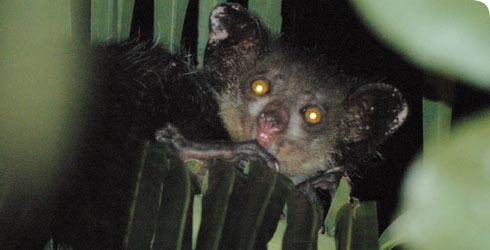Conservation
The aye aye is under threat from continued habitat destruction.
In addition, there are many superstitious beliefs attached to the aye aye.
The aye aye is disadvantaged by its unusual and even sinister appearance and behaviour - notably its huge spidery looking hands with a tapping bony finger, coarse black fur, bushy tail, bat-like ears, widely spaced shining eyes and nocturnal habits.
In parts of Madagascar, simply catching sight of an aye aye has been regarded as an ill omen or as the cause of previous bad fortune.
Aye ayes may approach the outskirts of a village in search or mangos, coconuts and other crops. An aye aye sighted near a village risks being killed and the corpse may be tied to a roadside pole outside a village so that the bad luck will be carried away.
For many years, aye ayes were considered to be near extinction and in an effort to save those that remained, 9 aye ayes were captured and released onto the small island of Nosy Mangabe in 1966. Studies in the 1990s suggest the population had taken hold and appeared to be thriving.
Aye ayes are now known to be more widely distributed on Madagascar and are found in several protected areas, but generally at low population densities.
